In Mohican, Heather Bruegl says, the shape of the language shows one person thinking of another. Between you and I, you come first.
“In English, we put ‘I’ first,” she says, “even in ‘I love you.’ In Mohican, ‘I love you’ translates into ‘it is you I love.’”
She is remembering storyteller and linguist Brock Schreiber, as he talks about what the shape of a language can say beyond the words. Mohican language shares an inclusive, caring way of thinking, she says, and she sees that way of thinking alive in their community, in their relationships with family, friends, partners and neighbors. People are looking out for each other.
She is sitting at a long wooden table by a painting in shades of the same deep red as the bowl of raspberries. Half of the walls are windows in this open room, and the sun dips out unexpectedly on a November morning. She is reflecting on the first season of The Forge Project in Taghkanic, N.Y., on an open hilltop between the Taconics and the Adirondacks.
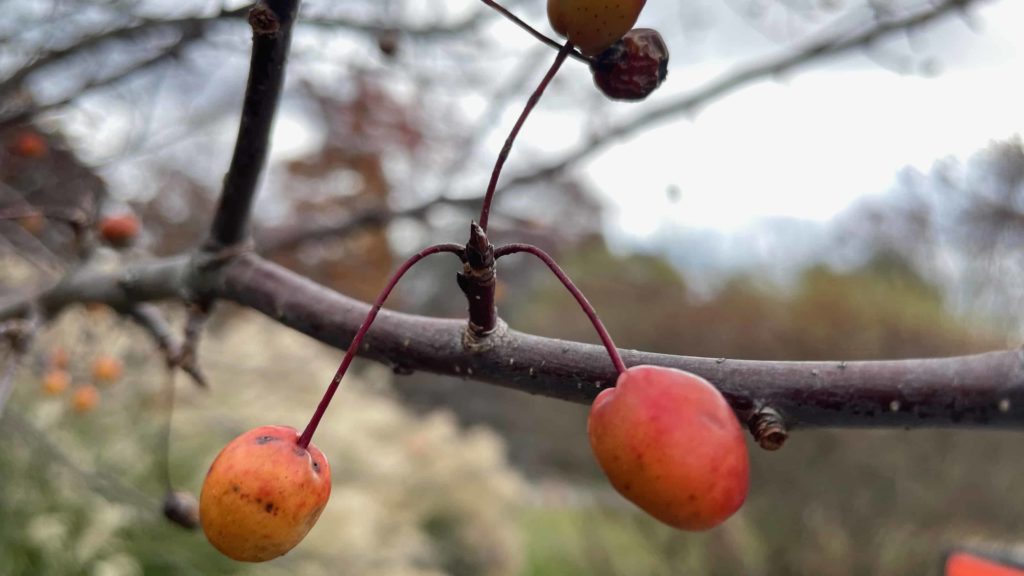
Fruits turn orange and gold in the fall at the Forge Project.
Launched in 2021, the Forge is a Native-led initiative to bring together and support Indigenous artists and leaders in culture, food security and land justice. It begins in two buildings designed by Ai Weiwei, the internationally honored Chinese architect and artist who has traveled and created work around the world, standing for democracy and human rights, from refugee camps to Alcatraz to Jerusalem.
Here he has imagined new spaces on the unceded and ancestral homelands of the Muh-he-con-ne-ok, The Mohican nation, the Peoples of the Waters that Are Never Still. The Forge recognizes a history to this land that is older than they are (as they say on their website before anything else).
They are working with communities across the continent to grow an arts fellowship program, public education and events, an art collection focused on living Indigenous artists, and a teaching farm grown in partnership with Sky High Farm.



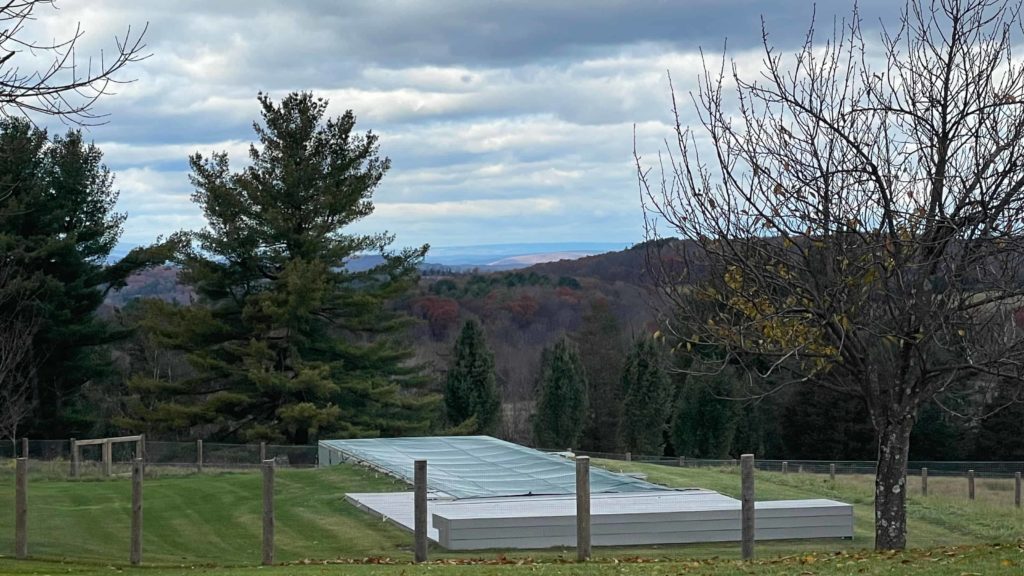
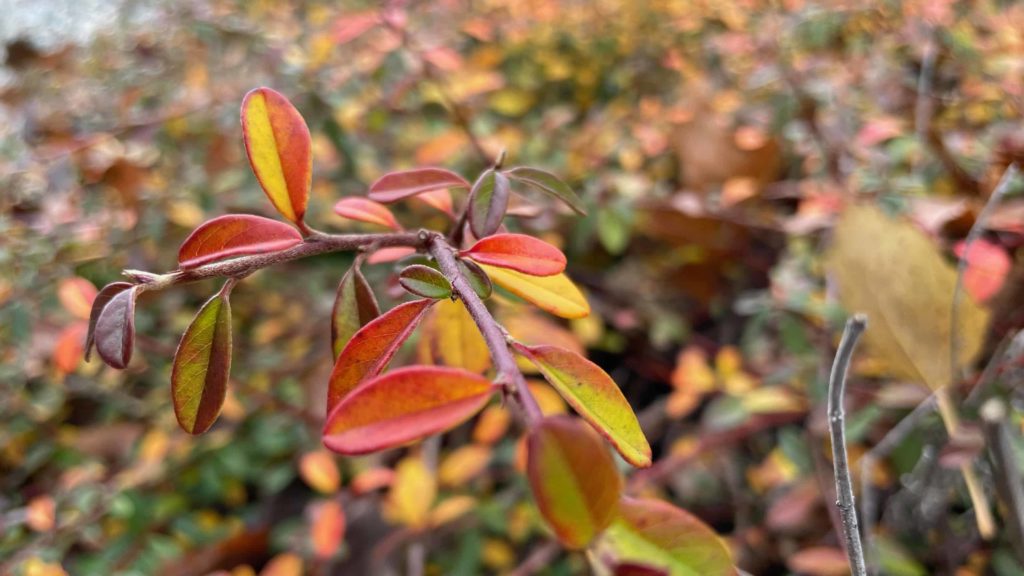
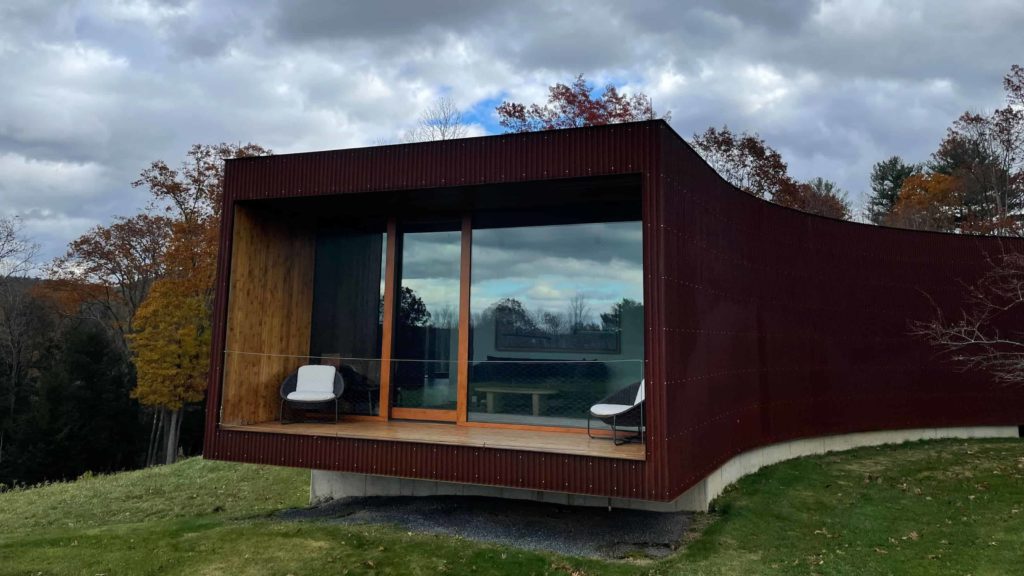
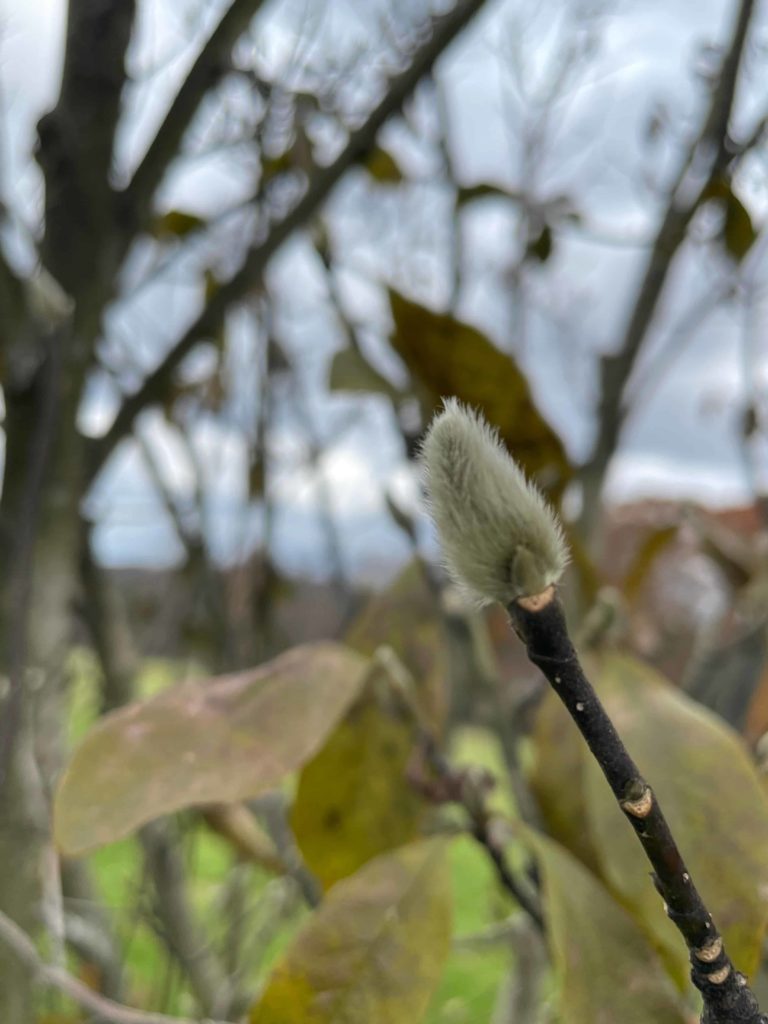
Bruegl came this summer as the director of education. She had served for many years as the director of cultural affairs for the Stockbridge Munsee community of the Mohican Nation in Wisconsin, she said, and she has been in conversation with the Forge for six months and more. In the virtual world of the pandemic, she gave an online talk with the Hudson Library, and Forge co-founder Zach Feuer heard her speak and reached out to her.
In August she began here full-time, long-distance, and in October she and her husband, and their dogs, all moved to upstate New York. This summer too she announced the artists in the first year of the Forge’s residency program.
One of the first focuses of her work here has been to meet Indigenous artists and talk with them about their work, she said. Creating the fellowship has given her the freedom to explore across all the nations on two continents, and she finds it exciting. She is a historian, she said, with a background in Indigenous culture and museums and archives and education. At the Forge she has allies in the art world.
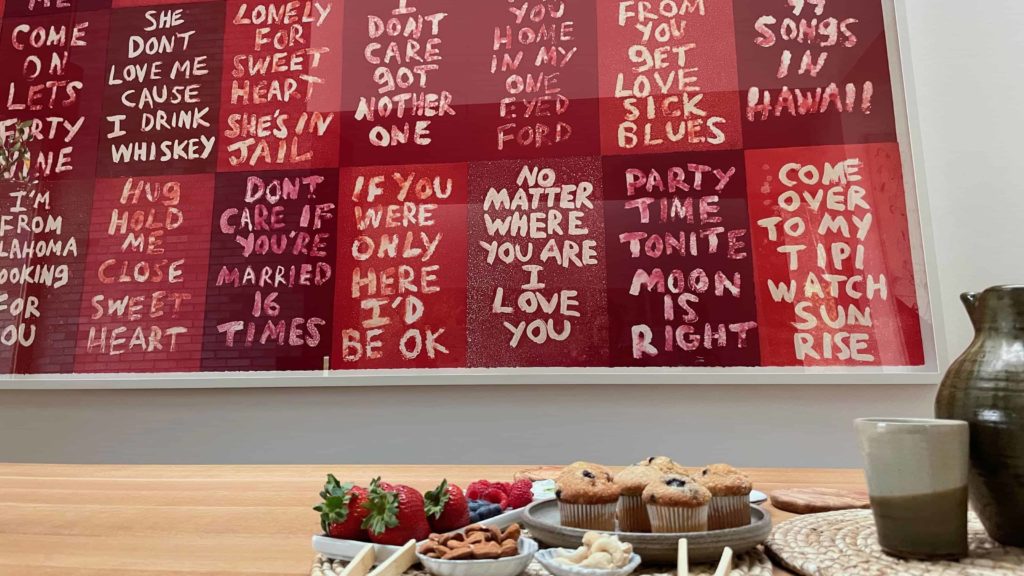
The Forge Project welcomes visitors with berries and muffins at a table beside a painting by the nationally acclaimed artist Edgar Heap of Birds.
Seeking out Indigenous artists
Director Candice Hopkins, a member of the Carcross/Tagish First Nations in in Canada, has served as a curator from the National Gallery of Canada to the Western Front, the Walter Phillips Gallery and the AIA Museum of Contemporary Native Arts in Santa Fe, New Mexico — and senior curator of the 2019 and 2021 editions of the Toronto Biennial of Art.
Feuer also has a broad background in contemporary art as co-founder of the Zach Feuer Gallery in Chelsea, in Manhattan, and former director of the Fields Sculpture Park at OMI International Art Center in Ghent, N.Y.
They have introduced Bruegl to Indigenous artists they know, as she has researched the field. She sees Indigenous artists doing amazing work, she said — in all kinds of fields and media — painting and sculpture, film and architecture, fiber art and photography, music and theater.
And their work is often wound round with community, activism, language and the land. They may be teaching, serving in local government, advocating in response to climate change and preserving traditional knowledge, she said. They may be caring for their children and their parents, and their neighbors. And most of the time, they also have to work full-time to pay the bills. The fellowship gives them the freedom to continue their work with stability for awhile.

Staff work from a laptop in the kitchen with a sweeping view at the Forge Project.
Native architecture in natiural forms
The first four artists have all lived in Wisconsin, she said, though Hopkina is local now, and Chris T. Cornelius is taking new position with the University of New Mexico as chair of their architecture department.
He is a citizen of the Oneida Nation, an internationally recognized architect and the founding principal of studio:indigenous.
In his design practice serving Indigenous communities, he imagines buildings and sculpture with organic forms — a translucent tapered cone in overlapping diamond shapes, or a school in a long, rounded, two-story building of tall windows and diagonal planes, and walls the gold and ochre color of pine wood or weathered sandstone.
He remembers coming here this summer and sitting outdoors on a warm day, talking with Hock E Aye Vi Edgar Heap of Birds, an artist who has shown his works at The Museum of Modern Art to the Venice Biennale.
Edgar Heap of Birds painted the broad painting that hangs behind Bruegl today, filling the wall in shades of red and words of love and loneliness. He is an artist of the Cheyenne and Arapaho Nations, and he came up from New York to speak. He is an elder, she said, and he and Cornelius sat on the porch, looking out over the mountains.
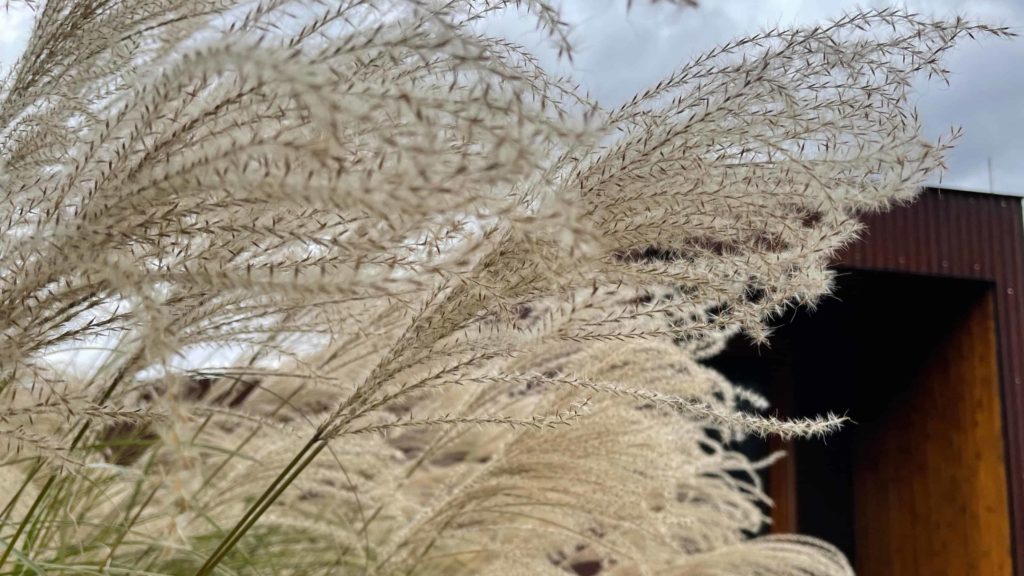
Internationally acclaimed architect Ai WeiWei designed the artist studio space at the Forge Project.
Holding light and flight on film
Sky Hopinka too blends images and words in his work. He is a visual artist and filmmaker and a member of the Ho-Chunk Nation /Pechanga Band of Luiseño, and he often brings together video, photography and spoken and written stories — he has shown his films at festivals from Sundance to ImagineNATIVE Media and Arts.
In one recent work, Here you are before the trees, he moves from this river valley to Wisconsin, following the journey the Mohican people have made from their homelands to his, in oral history and poetry. In his work, he often gathers personal stories, documentary and non-fiction to look closely at histories of place, Indigenous experiences and the interwoven relationships of language and the land.
He has talked with Bruegl about some of his newest work, she said, etched photographs and multi-channel video installations. The Forge has two or three of his works on their walls and another in the guest house — a photograph of geese against the sky, or light playing above the clouds.
Restoring knowledge of food and land
Jasmine Neosh works directly to protect the land. A Menominee writer, student researcher and advocate for environmental justice, she has been in Minnesota recently with protests against Line 3, Bruegl said, and with a background in environmental science, she is going to law school for environmental law and policy.
She is creating a field guide to restore knowledge surrounding food systems and native plants, according to the Forge, out of interrelated passions for Indigenous sovereignty, climate change education and sustainability rooted in culture and place.
Bruegl considers the depth of Indigenous knowledge in understanding the uses of plants, the lives of animals and the land. She thought of the Mohican word Mahicannituck, their name for the broad body of water that colonists called the Hudson River. Europeans gave 300 miles of water the name of one man, but the Mohicans call it the river that flows both ways, a tidal river.
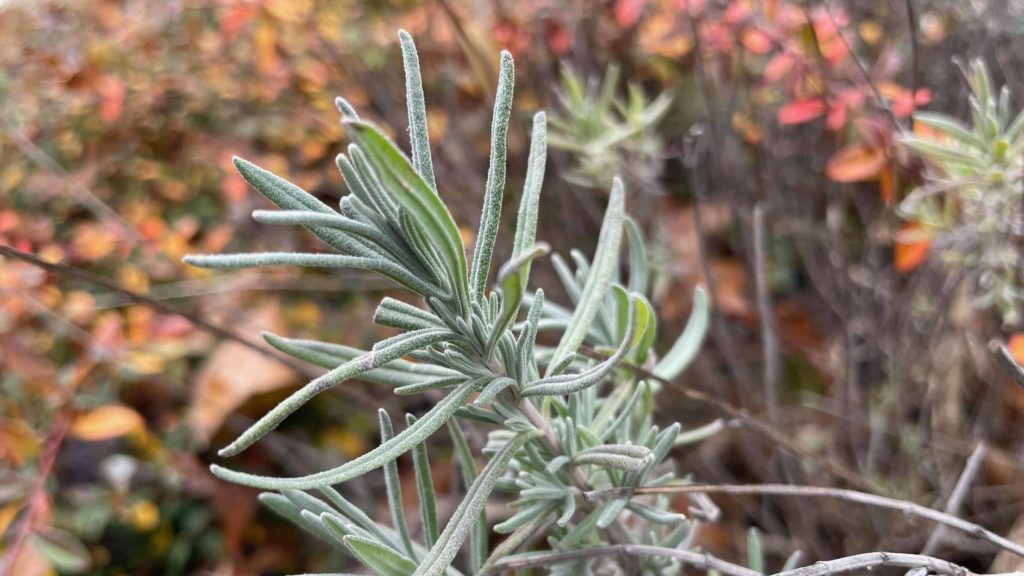
Rosemary still shows freen in the garden bed and shrubs turn orange and gold in the fall at the Forge Project.
When they lived here, they would have talked talked about places here familiarly, walking on the ridges and canoeing up the valleys. How would they have shared landmarks, an exposed face of quartzite, a stream bank where bloodroot grows? And their astronomy — what are their names for stars, and their constellations and the stories they tell?
Forge Project Fellow Jasmine Neosh Presents “The Land and You” with Director of Education Heather Bruegl from Forge Project on Vimeo.
Bringing language to new life
Brock Schreiber, a member and leader in the Stockbridge-Munsee community of the Mohicans, is looking toward that knowledge in his own way. He is among the leaders in revitalizing the Mohican language, Bruegl said.
Munsee has continued as a spoken language, but the Mohicans have not had fluent speakers, people who grew up speaking Mohican as their first familiar language, since the 1930s, and Schreiber is part of an ongoing effort to re-create it.
But he is working with Chris Harvey, the Mohican Community Linguist for the Stockbridge-Munsee Nation, to bring the Mã’eekaneeweexthowãakan language into contemporary life. They are drawing on written sources and languages that are close kin in the same Algonquian family, like Stockbridge Munsee, Bruegl said.
The Mohican Language Re-Awakened: A virtual event with Chris Harvey from Forge Project on Vimeo.
Bruegl feels a deep strength in being able to hear it spoken again. The version of the language spoken now, they call Stockbridge Mohican, she said, and it will be different in some ways from the language their ancestors have spoken in the past, because Schreiber and his fellow linguists cannot hear their voices.
Schreiber teaches the new language to new generations. He speaks Mohican with his children, and he writes children’s books and partners with Indigenous artists. He has three children, she said, and the fellowship will mean that his family does not have to sacrifice as much. He is working with his community too, teaching the language and serving on the Stockbridge-Munsee Tribal Council.
He wants to write a song, he has old her, and create a film to tell the story of the Mohican people.
Forge Project presents Brock Schreiber in conversation from Forge Project on Vimeo.
Re-creating and affirming community
The Forge will have one Mohican fellow every year, Bruegl said, in recognition that they are working and living on Mohican land. They have a growing library of books as well — and a growing community of artists and creative people. The fellows have the chance to know each other.
They have all spent time here in New York. Neosh and Cornelius came for a few weeks in warm weather, and Schreiber for a weekend. Hopinka lives nearby, so he has not stayed over, but he can come their to work — all of the fellows can choose to come for two to four weeks if they want to.
in March a gathering to bring them together, to hang out and bounce ideas off of each other. She has already seen ideas moving between them, she said. As they have held events to talk about their work, they are quoting each other. Schreiber, talking about language and the land, touched on Neosh’s talk on The Land and You.
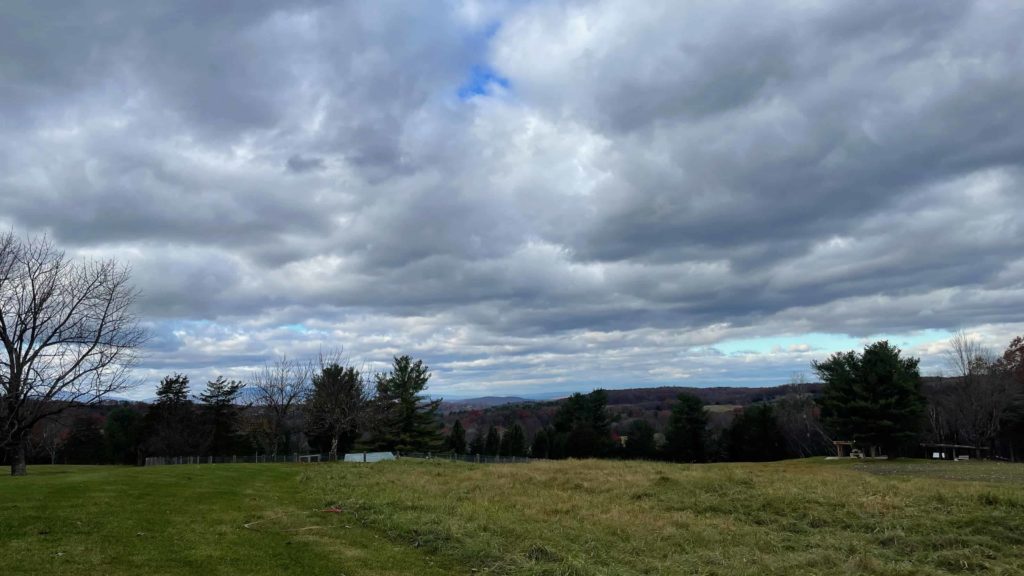
From the hilltop, the view stretches out broadly to the mountains on the horizon at the Forge Project.
Their relationships will go on past the fellowship, Bruegl said, as the Forge continues to give them a platform and space, and she hopes to bring them back for a reunion in the spring and as mentors to the next group of artists, and to support their work with people in their home communities.
“Creating community is something we do automatically,” she said. “It’s in our DNA.
They have survived centuries of colonial pressure and systematic disruption — policies up through the 1950s and beyond “relocated” Indigenous people off their reservations and into the cities, she said. People were forced to move away from their land and communities, their language and culture and their families. And that wrenching up by the roots brought deep pain. But so many people were forced to move in the cities, they found each other there and came together in new groups.
“The bond never breaks,” she said. “It’s ingrained in us. It’s part of who we are.”
This summer is the first time she has come east to her homelands here, she said, and she was nervous. But getting here and being on the land, she felt a sense of being home, even though at the time she still lived in Wisconsin then.
“Your body and soul knew you were home,” she said. “You know the land.”

